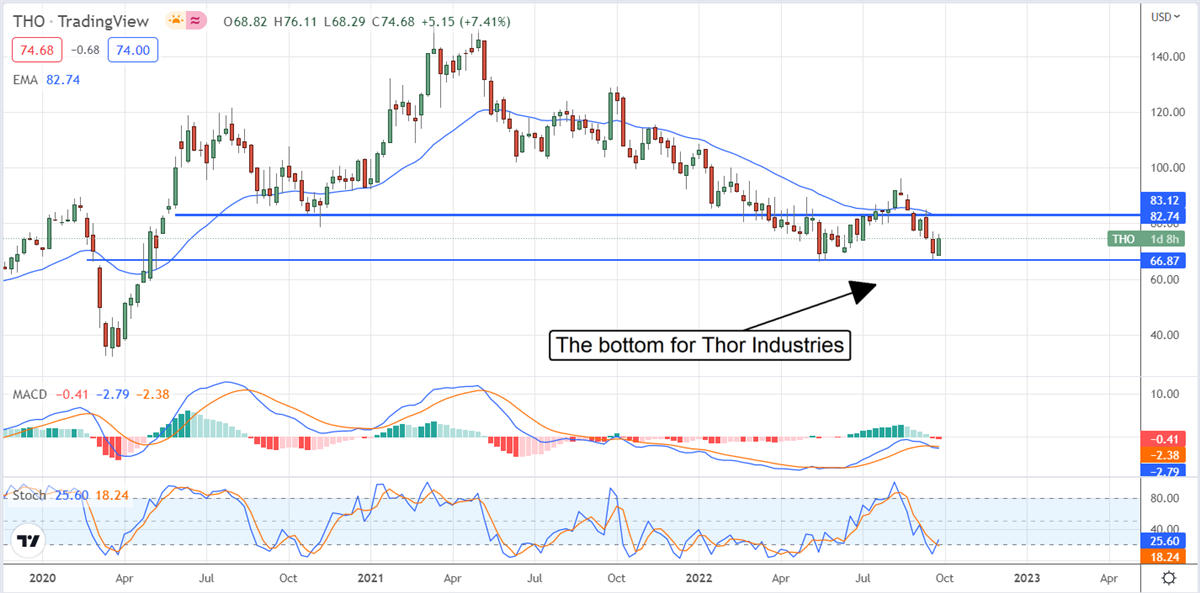Thor Industries Hammers Out A Bottom Thor Industries had another thunderous quarter with results that far exceeded the analyst's expectations. Institutions and insiders are buying the stock too.
This story originally appeared on MarketBeat

Lightning has struck so many times for Thor Industries (NYSE: THO) it's hard to count how many but it has happened once again. The company is still riding a wave of demand sparked by the pandemic and outperforming in all metrics. The only bad news is the evidence of peak RV sales is overwhelming and coincidentally comes with plans to begin giving full-year guidance. Thor Industries execs say they will start giving full-year guidance in tandem with the FQ1 report (calendar Q4) following its Dealer Open House which is happening now. What this means is execs are loath to give any form of guidance until they have a feel for what dealer demand will be in the face of slowing sales.
The latest data shows a 36% decline in YOY RV shipments, with weakness shown in most categories. The worst part of the report is that demand is expected to slow another 20% in 2023, which will weigh heavily on results. The takeaway for Thor investors is the market was already priced in the slowdown in demand a long time ago, and there are some compelling reasons to buy the stock now. Among them are the low 6.5X earnings multiple, the ultra-safe 2.3% dividend yield, the buyback program, and the FQ4 results.
Insiders And Institutions Buy RV, Recreation, and Camping Stocks
The insider and institutional activity in Thor Industries is telling, and this is true across the RV/recreational stock universe. Institutions and insiders are buying Camping World (NYSE: CWH), Winnebago (NYSE: WGO), and LCI Industries (NYSE: LCII), which suggests the value is compelling indeed. LCI Industries is the one standout because the institutional activity is a little on the mixed side but holding above 99% so there is that to consider. Additionally, all but Camping World are carrying relatively high short interest, which could help fuel or sustain a rebound once it is begun.
In the case of Thor Industries, five insiders, including four directors and the COO, have been buying over the past year and picked up about 0.1% of the stock. The insiders hold about 4.3% of the stock in total, and the institutions are even more bullish. Institutional activity is worth about 9.6% of the post-release market cap and has holdings up to 98.6%. On the analysts' end of the sell-side spectrum, they've pushed the consensus sentiment down to a firm Hold with a price target about 15% above the $75 level through a series of downgrades and price target reductions. That trend could change now the Q4 results are in, but caution is warranted until there is some indication of demand and/or guidance for F2023.
Thor Industries Has Thunderous Quarter
Thor Industries had a fantastic quarter in which both demand and margin exceeded the consensus estimates. The company reported $3.82 billion in net sales for a gain of 6.4% over last year. This includes an increase in sales prices and is offset by a slight decline in demand. The revenue is also 320 basis points better than expected and accompanied by a 90 basis point improvement in margin. The combined top-line strength and margin improvement were compounded by share repurchases to drive $5.15 in EPS or 25% YOY growth which was 3300 basis points better than expected. The takeaway here is the dividend is ultrasafe with its sub-5% payout ratio, and additional buybacks and dividend increases can be expected. The company upped its buyback allotment by $0.450 billion to $0.70 billion, or about 18% of the market cap.
The Technical Outlook: Thor Industries Hits Bottom
Thor Industries has been in an 18-month correction that began way back in early 2021 when it became apparent there would be a peak in RV demand. That sell-off hit several bottoms along the way, including one in mid-spring 2022. That bottom was confirmed in the wake of the Q4 results and could result in a reversal in price action over the next few quarters. Until then, the stock may move sideways within its new range while paying the 2.3% yield and buying back shares. 









